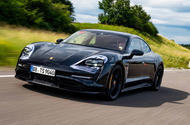Stuttgart’s groundbreaking 700bhp-plus pure-electric four-seat sports car is driven in pre-production form
For reasons I think I understand, this story feels different. Every week, we go some place to drive some thing, and lucky we are to do so. But to drive the first all-electric Porsche – well that, surely, is different.Different because Porsche and electricity seem as natural a fit as fire and ice. Different because if Porsche really can pull it off and produce the world’s first electric production driver’s car, the ramifications could be enormous. But, for Porsche, perhaps not quite so enormous if it cannot.Because of the way the media is micro-managed these days, especially with cars as important as this, there is still much about the Porsche Taycan I am not allowed to say, because the car has yet even to be unveiled. So far as official information is concerned, all that exists is what Porsche published when it revealed the Mission E concept in 2015, most of which is now obsolete.If what follows seems more speculative than factual, you could nevertheless conclude that I know rather more than I’m saying, because not being specific was a condition of getting in the car. I shall therefore leave it to you to decide how well informed such speculation might be. In the words of Francis Urquhart: ‘You might think that. I couldn’t possibly comment…’There are, in fact, two Taycans, at least that Porsche is owning up to. Actually, there’s certainly a third and very probably a fourth, but in these days of top-down launches, these are less powerful versions that have yet to be seen or driven, officially or otherwise. Which leaves us with the two top cars, widely rumoured to be called Turbo and Turbo S, in line with Porsche’s naming convention. (I know it seems strange given neither even has an engine let alone a turbocharger, but we’ll get used to it.)Both have batteries rated above 90kWh and standard power outputs substantially in excess of 600bhp. The difference (besides the S having ceramic brakes, a stiffer set-up, standard four-wheel steering and 21in wheels clothed in high-performance tyres) is that while both will ‘overboost’ for 2.5sec at the time, the S will do so rather more, raising its total output to well over 700bhp, with in excess of 750lb ft.So while the car is predictably heavy – think something around the 2.25-tonne mark – so too is it blindingly quick. The 0-62mph time of the Mission E was quoted at 3.2sec, and I’d expect a Taycan Turbo S to be as far below the three-second mark as the E was above it.When I drove both cars in prototype form, their interiors were completely camouflaged but have since been revealed to feature next-generation high-definition imaging that, if you choose the optional passenger information display, provides TFT screens almost from wall to wall across the entire width of the car. It looks quite intimidating but, in terms of the admittedly limited operations I was able to use, it all works fairly intuitively.
Source: Autocar
